|
EXPLODING MREsJULY 07 -- BOISE, IDAHO: Forest Service safety managers have issued a safety alert warning about explosion hazards associated with MREs (Meals Ready-to-Eat) and specifically, the food heating device found in hot meal packets. The Flameless Ration Heater (FRH) is developed by using hypercorrsoion of a magnesium-iron alloy. The FRH is packaged with every MRE. If the MREs are exposed to fire and the magnesium powder ignites, a class D fire will occur, exhibiting sparking and flare-up if sprayed with water.

If the plastic pouch containing the FRH melts, adding water to the magnesium-iron compound can cause the production of hydrogen, and if that accumulates in a confined space, the fire can intensify and an explosion may occur.
Cache managers were warned that if the FRH continues to smoke or sizzle after the flames are out, hydrogen is being produced and poses a respiratory hazard. If the magnesium becomes involved, neither foam nor water should be used to extinguish the MRE.
Warehouses with large quantities of FRH pallets in storage should protect the cases from physical damage and from water in any form, including leaks, snow, rain, or flooding. Damaged cases should be handled with particular care since they are more vulnerable to activation by water. Equipment for fighting Class A and Class D fires should be available, and proper ventilation should be provided so that hydrogen will not build up to an explosive concentration.
The safety alert also recommended that training be provided to local fire services in fighting combined Class A and Class D FRH fires. Appropriate warning labels should be placed on the exterior of the case and should be visible when cases are stacked on a pallet.
Unused MRE heaters are considered a hazardous waste by the EPA, and must not be disposed of in the regular trash. They should be recycled through the Defense Re-use and Marketing Office (DRMO) or other qualified recycling program. Unused heaters can also be activated as per manufacturer's instructions and then disposed of as ordinary garbage.
Collecting and storing unused MRE heaters when the real intent is found not to be reuse as an MRE heater is a violation of federal law.
Questions should be directed to your local/regional Hazardous Materials Coordinator or to Gary Hoshide at (406)329-1029 or Allison Good at (202)205-2934.
The complete 3-page safety alert is available online as a 192k PDF document.

POT PEAK FIRE GROWINGJULY 06 -- CHELAN, WA: Firefighters deepened burnout areas on the Pot Peak Fire yesterday, using aerial ignition on the northern end of Slide Ridge south to Slide Peak. Burnout operations continued from Slide Peak toward Stormy Mountain, and crews started burning out in the area of the confluence of Darby Draw and the North Fork to create a fire-safe boundary for structures in Twentyfive Mile Creek and along the southern shore of Lake Chelan.
The Pot Peak Fire is not threatening the community of Chelan or recreation use on Lake Chelan, and all businesses are open to visitors.
The main fire, about 15 miles west of Lake Chelan, will continue to back down toward the North Fork of Twentyfive Mile Creek, according to Lohrey's Type 1 team, which is managing the fire. On the south end, the fire is advancing on Slide Ridge. Heavy fuels in the burnout areas in the northeastern area of the fire are causing the fire to back down the ridge at a rate of 10-15 feet per hour. Helicopters are dropping water and retardant to cool the leading edges of the fire.
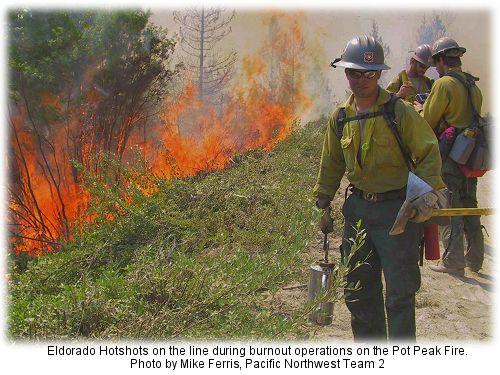
The fire was ignited by lightning on June 26 and is now about 35 percent contained at 6,550 acres. Almost 900 personnel are on the fire, along with 26 engines, five dozers, 19 tenders, and a dozen helicopters.
KOMO-TV reported that Douglas County sheriff's officials advised people who live near the Beebe Bridge Fire, east of the lake and the Columbia River, to evacuate after strong winds pushed the blaze a half mile north overnight. The fire covered about 3,000 acres -- up from 2,000 the day before -- and was burning about a quarter mile from some homes. The Beebe Bridge fire was started by an owl with a chicken.
A cold front is expected to bring strong winds over the fires this afternoon. Winds are expected be 6 to 10 mph from the west-northwest with gusts to 10 mph. Clouds should increase this afternoon, with a 30 percent chance of showers.

BOOK REVIEW:
JACK WARD THOMAS:
The Journals of a Forest Service ChiefJULY 06 -- MISSOULA, MT: In the summer of 1986, Jack Ward Thomas began keeping a journal. "This will be a journal of random thoughts," he wrote. "My purpose is unknown to me, but I feel a compulsion to begin. Perhaps it will serve as a tickler of memory for the book I intend to write, but of course never will."
This first book from Jack Ward Thomas is sure to open the eyes of those who think they know how policy and management decisions affecting the nation's forests are made. Though Thomas has authored well over 400 publications, mostly on wildlife conservation, perhaps the most valuable thing he's written is the set of journals he started eighteen years ago - the book he intended to write.
As Chief of the Forest Service, Thomas is quick to give credit to those he respects, particularly his agency employees in the field. But he doesn't shy from battle, and his assessments of some political appointees in Washington and certain members of Congress are brutal.
 Thomas was drafted into the chief's job shortly after Clinton took office, and he took the helm of the agency with typical fortitude - and the naiveté of a researcher thrust into the political cauldron that is Washington DC. Thomas was drafted into the chief's job shortly after Clinton took office, and he took the helm of the agency with typical fortitude - and the naiveté of a researcher thrust into the political cauldron that is Washington DC.
"We don't just manage land," he wrote, "we're supposed to be leaders. Conservation leaders. Leaders in protecting and improving the land."
Statements like that surprised some of the people in Washington, but certainly didn't surprise his longtime friends and colleagues. Thomas had been talking about and writing about conservation for most of his life. And the cream of that conservation writing is in his journals. This book offers not only insight into the mind and heart of a naturalist, but also a perspective on the politics of natural resource management through the eyes of one of this country's finest conservationists. His writings clarify many of the environmental issues we face today: protecting obscure but endangered species, dealing with wildfire and wildfire fatalities, balancing resource needs against the need to preserve, and the development of policies to address forest health.
This book's a treasure, and will be a valuable addition to the collections of those who care about natural resources management.
The first edition of the book sold out in less than a month. You can order a copy at amazon.com or from your local bookseller.

TANKERS WORKING ARIZONA FIRESJULY 06 -- SAFFORD, AZ: Two of Aero Union's P-3 Orions bought fire crews some extra time yesterday afternoon when they dropped loads of retardant in front of the advancing Gibson Fire on Mt. Graham.
"It was nice to have them back," said Incident Commander Dan Oltrogge. "We like to have all the tools we can."
 Oltrogge's team is managing the Nuttall Complex; the Tucson Citizen reported that it's burned 16,360 acres in the Pinaleño Mountains. The Gibson Fire is threatening the Mount Graham International Observatory. Oltrogge's team is managing the Nuttall Complex; the Tucson Citizen reported that it's burned 16,360 acres in the Pinaleño Mountains. The Gibson Fire is threatening the Mount Graham International Observatory.
The fire came within three-quarters of a mile of the observatory Saturday but did not progress any further, according to the Eastern Arizona Courier.
Dr. John M. Hill, director of the Large Binocular Telescope Project, said he was a little nervous as the flames approached the observatory Saturday, but he was more optimistic by Monday.
"Today seems a little better than Saturday," he said. "I feel a little better every time I look at the web cam and see the little green buses for the hotshot crews in front of the building."
Alex Stone, director of air operations on the team, said the tankers had already dropped retardant on the Willow Fire near Payson and made six runs on the Nuttall Complex before flying to a new fire on the Gila National Forest yesterday. The airtankers, along with a dozen helicopters, have been supporting 22 ground crews working to protect the observatory and the mountain communities of Columbine and Turkey Flat.
Rick Kvale, aviation officer, said the fire area includes near-vertical slopes up to 90 percent. "That's too steep to put firefighters in," he said.
Oltrogge said about 150 firefighters are working in the area immediately surrounding the observatory. They plan to connect existing roads by clearing land with dozers and then using the roads for firelines.
Three observatory employees remain atop Mount Graham with the $130 million telescopes. "The building's not going to burn, but the smoke and heat could do some real damage to the instruments inside," said Pruett Small, operations section chief.
When fully operational in 2005, the Large Binocular Telescope will be the world's most technologically advanced optical telescope. It is expected to yield images nearly 10 times sharper than those from the Hubble Space Telescope.

FIVE AIRTANKERS BACK ON DUTY, MORE PENDINGJULY 05 -- CHICO, CA: Five of the 33 airtankers canceled in May by federal firefighting agencies are back in the air, and several more are staged for approval.
"With only five of the tankers initially going back to service, it was a tough decision on where to station them," said Jo Simpson with the BLM in Reno. "They're being spaced out across the West to provide the best geographic coverage with limited availability."
The Salt Lake Tribune reported that the Forest Service was in the final stages of signing contracts for the five planes on Saturday. The current renegotiated contracts are for 90 days on the Aero Union P-3 tankers.
 There are no "home bases" for the current reincarnation of airtanker contracts; the home base for Aero Union's P-3s will be Chico, California. A letter of inspection from DynCorp to the Forest Service was delayed by holiday mail slow-downs, which has temporarily stalled the return to service of two more P-3's owned by Aero Union. There are no "home bases" for the current reincarnation of airtanker contracts; the home base for Aero Union's P-3s will be Chico, California. A letter of inspection from DynCorp to the Forest Service was delayed by holiday mail slow-downs, which has temporarily stalled the return to service of two more P-3's owned by Aero Union.
Five of Aero Union's airtankers left yesterday, though, for their initial assignments. Tanker 22, piloted by Dean Talley, was sent to Cedar City, Utah. Captain Bill Waldman will be piloting Tanker 27 out of Winslow, Arizona, and Tanker 26 will fly out of Prescott, Arizona, with Greg Hock in command. Tanker 23 is initially based at Fox in southern California and piloted by Phil Darnell. Tanker 21 and Captain Jan Reifenberg will be in Fairbanks, Alaska.
Tanker 25 with Brent Conner in the cockpit will probably be sent to Moses Lake, Washington, and Gary Schooler will probably take T-20 to Battle Mountain, Nevada, as soon as they have the authority to fly.
Tanker 00 is still in the Aero Union shop in Chico, because maintenance on that P-3 was halted when the contracts were cancelled. That ship may be back up as soon as the second week in August.
Aero Union's package on the DC-4 aircraft is still in progress and could be approved in another month.
Fire managers in the areas where tankers will be initially deployed are grateful to have their heavy aerial resources back online. "Having a tanker stationed out of Battle Mountain will benefit all the wildland firefighting agencies in the Great Basin," said Kevin Hull, BLM chief of fire and aviation in Nevada. Arizona reportedly requested three of the five initially approved tankers, but will probably get just the two at Winslow and Prescott. If the southwest monsoons arrive soon, as is typical for mid-July, those aircraft could be quickly reassigned to other bases with heavier fire activity and more severe fire danger.
The Associated Airtanker Pilots (AAP), by the way, has an online store with caps, T·shirts, mousepads, postcards, and other cool stuff at cafeshops.com/wildfirenews/102588 and ALL PROCEEDS from that online store benefit the pilots' memorial fund.

AERIAL FIREFIGHTING COSTS UNCLEARJULY 04 -- PRESCOTT, AZ: Expenses for aerial firefighting are likely to increase this year, with federal officials estimating the cost at $66 million for supplemental aerial resources after canceling the heavy airtanker contracts in May. An internal agency plan estimated $1.3 million per two-week pay period for the Southwestern Region of the Forest Service to add seven medium and two heavy helicopters, eight SEATs, 20 smokejumpers, and two air tactical group supervisors to fill in for the loss of the heavy tankers this year.
Those figures don’t include the cost of flying, only of making the aircraft available. And, as the Prescott Daily Courier reported, that does not include the costs for the two military C-130 tankers stationed in Mesa. Those figures are calculated differently, because the feds have to cover the cost of lodging, meals, transportation, and salaries for two crews of about 30 personnel each.
"We don’t know what it’s going to cost until it’s all done," said Lt. Col. Rob Garza of the U.S. Northern Command.
The privately contracted heavy airtankers, on the other hand, come with crews of three, and contractors are paid for stand-by and flight hours.
The federal agencies figured they saved $20 million by canceling the $30 million tanker contracts, but expected to pay the contractors $10 million anyway.
Tanker industry owners have long complained that the Forest Service has been keeping them from updating their aircraft by keeping contract prices suppressed.
"For 50 years the agencies have been 'low-balling' their budgets in not just this arena but all areas, a point that was well-emphasized in the Blue Ribbon Panel Report," wrote retired aviation specialist Hugh Carson. "Part of the problem is that we have never had a leader that had the courage to stand in front of Congress and tell them the truth, i.e., that this is a highly complex, high-risk business that deserves first-class training, equipment and aircraft."
The Blue Ribbon Panel concluded that federal firefighting contracts ignore safety in the "widespread short-term pursuit of cost efficiency."
Congress added $500 million to this year’s $790 million firefighting budget to help stop the practice of raiding other accounts -- including forest restoration and fuels reduction projects -- to pay for firefighting, yet Forest Service program managers have already been told to spend whatever funds they have available in this year's budget as soon as possible because it's expected that their budgets will be raided for fire costs again this year.

COLORADO RESIDENTS EVACUATEDJULY 04 -- CEDAREDGE, CO: Evacuation notices were given yesterday afternoon to 129 Cedaredge residents threatened by a 2,000-acre fire on the south flank of Grand Mesa. The Grand Junction Daily Sentinel reported that the Red Cross set up a shelter for residents displaced by the McGruder Fire, which burned to within 200 yards of Cedaredge homes.
Mullenix's Type 2 team has been ordered.
It was one of four fires local officials were fighting yesterday. The 20-acre Tappan Fire burned south of Montrose, and north of Mesa County near Douglas Pass, firefighters were working on two fires that were ignited Friday afternoon. The Long Point Fire west of Barrel Creek was at 60 acres with two hotshot crews and four SEATs assigned.

SHELTER DEPLOYMENT ON NUTTALL COMPLEXJULY 03 -- SAFFORD, AZ: Crews are working to keep a 200-acre lightning-caused fire away from the Mount Graham International Observatory, home to some of the world's most powerful telescopes. The Tucson Citizen reported that the fire was 1½ miles from the observatory last night, prompting a precautionary evacuation of the area.
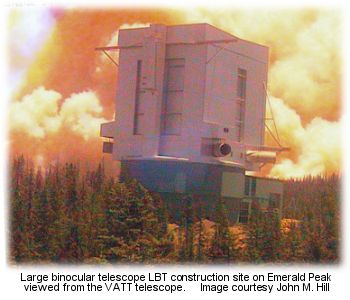 Firefighters were briefly pulled off the Nuttall Complex Friday, and about 10 firefighters had to deploy emergency shelters early in the afternoon. Officials had not yet determined why the deployment occurred, but fire activity had reportedly increased. All of the firefighters were reportedly okay, with no injuries. Firefighters were briefly pulled off the Nuttall Complex Friday, and about 10 firefighters had to deploy emergency shelters early in the afternoon. Officials had not yet determined why the deployment occurred, but fire activity had reportedly increased. All of the firefighters were reportedly okay, with no injuries.
Threatened structures include 25 homes, 10 commercial buildings, and two outbuildings.
The Gibson Fire, part of the Nuttall Complex, started June 22 and remained small, burning in steep terrain, until it took off yesterday. The fire more than doubled in size, making upslope runs; it's burning in a large stand of bug-killed trees.
Oltrogge's Type 1 team is managing the complex, which is about 15 miles southwest of Safford. It includes both the Nuttall and Gibson fires, and was 5 percent contained last night at 2,700 acres. The Nuttall Fire yesterday included extreme plume-dominated fire behavior, and the Gibson Fire was active with upslope runs and spotting. Crews are working on burnout operations and line construction on the Nuttall Fire, and the Gibson Fire will be monitored from the air. Structure protection is being put in place around the observatory.
Huge plumes of smoke were visible this morning from the Emerald Peak webcam.

FIVE AERO UNION TANKERS APPROVED TO FLYJULY 02 -- BOISE, IDAHO: Officials announced today that five heavy airtankers will return to service as early as next week. The decision follows the safety analysis conducted by DynCorp on eight Aero Union aircraft; inspections are continuing on the other three. The airtankers are all P-3 Orions.
"Being able to bring these assets back into the fire managers' toolbox is a real benefit," said BLM Director Kathleen Clarke.
On June 9 the Forest Service signed an agreement with Texas-based DynCorp Technical Services, the company that manages California's fleet of S-2 tankers, to analyze the airworthiness documentation provided by contractors at the request of the Forest Service.
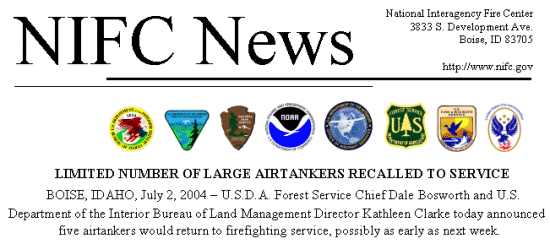 The Forest Service contracting unit at NIFC is currently negotiating a new contract with Aero Union for the airtankers, and the cost at this time is unknown. The negotiation process will take about a day, according to NIFC. The Forest Service fixed-wing specialist will travel over the weekend to Chico to check ride with the pilots and re-establish their qualifications. The aircraft are expected to be available for initial attack by Monday.
The Forest Service contracting unit at NIFC is currently negotiating a new contract with Aero Union for the airtankers, and the cost at this time is unknown. The negotiation process will take about a day, according to NIFC. The Forest Service fixed-wing specialist will travel over the weekend to Chico to check ride with the pilots and re-establish their qualifications. The aircraft are expected to be available for initial attack by Monday.
Potential for new wildfires will determine where the five tankers will be assigned, and their locations will be decided by the National MAC group.
DynCorp is currently examining the data packages from five other contractors, and will submit reports as they are completed.

USMC HASN'T PAID OLD SUPPRESSION BILLJULY 02 -- CARSON CITY, NV: A $10 million bill sent to the Marine Corps to cover the costs of fighting a 22,750-acre fire two years ago has still not been paid. The 2002 fire started near Pickel Meadows where trainees had set dozens of practice campfires. After sending the bill in January 2003, the Forest Service said negotiations had started with the Marines Corps over the costs for fighting the fire and doing associated post-fire rehab.
The Pickel Meadows base is on the Humboldt-Toiyabe National Forest, and the AP reported that existing agreements between the USMC and the USFS required the Defense Department to pay for any costs directly attributable to military training in the area.
The 2002 fire was about 20 miles south of a 940-acre fire that started earlier this week and evacuated a Marine Corps housing compound near the Pickel Meadows base. This year's fire was apparently ignited when four kids lit a cooking fire and embers blew into nearby brush. The Mono County district attorney's office is determining whether charges should be filed -- and another bill for firefighting could be sent out. Children of Marines were involved in the latest fire, and reimbursement costs would be billed to their parents rather than to the military.

ARIZONA: "WE'RE GIVING IT OUR BEST SHOT"JULY 01 -- PAYSON, AZ: Firefighters on the Willow Fire, the state's largest wildfire this year, are fighting without their biggest tool. Nearly two months after the cancellation of contracts for the nation's heavy airtanker fleet, wildfires like the one southwest of Payson are being fought differently, according to a report by the Arizona Republic.
Firefighters say they've had to shift strategies since the airtankers were pulled from service. SEATs and helicopters are being used more frequently -- and sooner -- in an attempt to fill the gap. They dumped hundreds of thousands of gallons on the Willow Fire Monday, but the fire is still nowhere near containment.
"If we had some heavy airtankers, it would help greatly," said Danny Kellogg, the U.S. Forest Service's Southern regional aviation operations specialist from Atlanta. "We're giving it our best shot with what we've got at our disposal."
A report in today's East Valley Tribune accuses federal officials of understating the crucial role of heavy airtankers since their contracts were canceled in May.
Jim "Mr. Arizona" Paxon, a Show Low resident and retired Forest Service fire information officer, has written letters to Congress and other decision makers urging them to rethink their decision. The airtankers are critical in fighting large wildfires and in preventing small fires from growing out of control, he wrote. Paxon said he was disappointed that officials have downplayed the airtankers' worth.
Forest Service officials have been assuring the public that the airtankers are not as effective as supporters believe, and that other aircraft being deployed are just as good. Bob Simpson, the Forest Service SEAT manager on the Willow Fire, for example, told a reporter this week that SEATs are "just as efficient for initial attack," and Kellogg said that heavy airtankers dropped only 20 percent of the retardant on fires over the past 10 years -- a mind-boggling but oft-repeated miscalcuation. Rob Crouch with with Fire-Trol in Phoenix said that was absolutely not correct. He says Fire-Trol supplies most of the retardant in the state, and that in recent years 80 percent of their retardant was used by heavy airtankers.
Other employees have been throwing around fuzzy math and misleading figures about the effectiveness of SEATs and helicopters.
In a recent email of canned "talking points" distributed to other employees, a Forest Service public affairs staffer told employees to be careful about their language when discussing airtanker issues. Rose Davis at NIFC made some good suggestions for accuracy, such as using "airtankers" rather than "bombers," but several other tips for "we say this and we don't say that" really put the spin on the issue. Airtankers, she wrote, should be referred to not as "vintage aircraft" but as "aging aircraft."
"We do not talk about capacity or gallonage of airtankers vs. helicopters or SEATs," was another suggestion. But the capacity of heavy airtankers is one of their key strengths. SEATs on the Willow Fire have been dropping 500 gallons per load. The typical heavy airtanker carries 2,000 to 3,000 gallons at a time.
The impact of removing the heavies from the firefighting "toolbox" will be evaluated over time, but some say the difference is already apparent.
Last week on Mount Graham, for example, lightning started several fires that were burning in an area including threatened and endangered species and a multi-million-dollar telescope facility. A heavy airtanker would have had a decent chance at snuffing those fires quickly, said Pete Gordon, deputy fire management officer for the Coronado National Forest. "If we had the P-3 available, it would have been very effective, I think, in getting through," Gordon said. "It was what it was designed to do."

MORE EVACUATIONS IN ALASKAJULY 01 -- FAIRBANKS, ALASKA: Hundreds of people, including about 200 workers at the state's largest gold mine, have left their homes and made their way to Fairbanks ahead of a 117,000-acre fire in Alaska's interior. Evacuations were ordered yesterday when winds picked up and pushed the fire toward homes. The Anchorage Daily News reported that firefighters and state troopers went door-to-door and telephoned residents. About half the workforce of the Fort Knox gold mine was evacuated, and mine officials shut down the $600 million operation.

BITTERROOT 'SHOTS UPDATEJULY 01 -- SOCORRO, NM: Three members of the Bitterroot Hotshot Crew remain hospitalized today after their crew vehicle was involved in a collision with an RV yesterday morning near Socorro.
The driver of the RV, Tim Schultz from Datil, New Mexico, was killed, and nine others were injured.
 Bitterroot Hotshot Nicole Lustig is in critical condition with head injuries, and Jared Bohrman is still in guarded condition with chest injuries. Both were airlifted to the UNM hospital and seven others were transported to the Socorro hospital. All but one of the seven have been released; firefighter Mike King remains in the hospital for observation. He was in good condition this morning. Bitterroot Hotshot Nicole Lustig is in critical condition with head injuries, and Jared Bohrman is still in guarded condition with chest injuries. Both were airlifted to the UNM hospital and seven others were transported to the Socorro hospital. All but one of the seven have been released; firefighter Mike King remains in the hospital for observation. He was in good condition this morning.
The other hospitalized crewmembers -- Jay Wood, Jude Waerig, Bill McMaster, Skylar Brown, Richard Griffin, and Lisa Kurtzhals -- have all been released. Travel arrangements for the crew are being made for their return to return to Montana.

CREWS BATTLING FIRE NEAR PAYSONJULY 01 -- PAYSON, AZ: Smoke from the Willow Fire filled the air yesterday, and Payson residents worried that the fire was growing, but officials say it remained at 32,000 acres throughout the day. Most of the smoke was from unburned islands of fuels within the fireline, according to a report by the Payson Roundup.
Buck Wickham with the Southwest Area Type 1 Incident Management Team said the fire is 5 percent contained, and though the team has not ruled out an evacuation, they say the chances are slim. Wickham said last night, though, that he couldn't say the same for the communities of Pine and Strawberry.
Crews are attempting to maintain the firebreak of the East Verde River between the fire and the two mountain communities north of Payson. "The fire has jumped the East Verde River several times," said Wickham, "but firefighters have been able to turn it back."
Crews have burned a two-mile firebreak around control lines, according to the Arizona Republic, and the fire's about four miles southwest of Payson. "There is quite a bit of distance between the burnout and the fire itself, so it will take a day or two for those to meet," said Ron Meyer, another fire information officer for the team. He said 17 buildings, including homes, barns and sheds, were still considered threatened by the fire.
West of Rye yesterday, two C-130 MAFFS units dropped retardant on a smaller fire that started when a bulldozer was cutting line. Wickham said in 35 years he'd never seen a fire started by a bulldozer.
Nearly 800 firefighters are on the Willow Fire, along with four SEATs, five helicopters, 28 engines, five water tenders, and a half dozen dozers.

HOTSHOTS INJURED IN VEHICLE ACCIDENT IN NEW MEXICOJUNE 30 -- SOCORRO, NM: A hotshot crew on their way to the Davenport Fire near Datil was involved in a vehicle accident with an RV near Socorro this morning. The driver of the RV was fatally injured.
Six of the Bitterroot Hotshots from Montana were injured and were transported to hospitals in Socorro and Albuquerque. Four of the 'shots were treated and released in nearby Socorro, and the other two were transported to Albuquerque where one is in critical conditon tonight and another is reportedly in guarded condition. There were other injuries in the RV, but details tonight are sketchy.
The Bitterroot Hotshots were reportedly on their way to their last shift on a fire on the nearby Cibola National Forest when the wreck occurred.
KRQE-TV reported that the crew buggy and an RV collided west of Socorro, killing the RV’s driver and injuring crewmembers in a head-on collision about 9:30 a.m.
The driver of the eastbound RV reportedly lost control of the vehicle after a tire blowout before the wreck, swerving into the westbound lane and slamming into the hotshots' vehicle. The first hotshot crew vehicle swerved and missed the RV, but the second one was hit head-on by the out-of-control RV. Two ambulances and a lifeguard helicopter responded to the wreck. The driver of the RV was pronounced dead at the scene of the crash.
The Davenport Fire was contained Monday at about 200 acres on the Cibola National Forest in west-central New Mexico.

7,000 LIGHTNING STRIKES IN NORTHERN CALIFORNIAJUNE 30 -- CHICO, CA: Lightning strikes over the north state Monday night touched off dozens of forest fires in northern California forests, but none of them got away. The Chico Enterprise-Record reported that more than 7,000 lightning strikes were recorded overnight between Monday and Tuesday, touching off small fires from Amador County to the Oregon border and west to Humboldt County.
The Plumas National Forest reported 40 to 45 small fires, but all were kept to under an acre. On the Shasta-Trinity, firefighters had 19 confirmed fires. The largest reached five acres; one fire north of Shasta Lake was attacked by smokejumpers. On the Mendocino, 12 fires were reported; the largest was a half-acre fire in the Yolla Bolly Wilderness. Smokejumpers were also committed on that fire.
For answers to all your questions about lightning (and then some), check out the lightning page from www.sky-fire.tv in Fort Collins, Colorado.

DOZENS EVACUATED IN ALASKAJUNE 30 -- FAIRBANKS, ALASKA: Dozens of people fled their homes and took refuge at a lodge northeast of Fairbanks after winds gusting to 30 mph whipped a wildfire in Alaska's Interior. State troopers closed the Steese Highway and asked residents to evacuate to the Chatanika Lodge about eight miles away. The AP reported that at least a dozen homes were threatened; a Type 2 team has been ordered.
Winds picked up in the afternoon and pushed the fire over a ridge and toward homes; an evacuation center was set up at a high school in Fairbanks.
The Boundary Fire grew substantially overnight, burning from about 75,000 acres to 117,000 acres, about 50 miles northeast of Fairbanks, said fire information officer Michelle Finch. The fire jumped the Steese Highway and was burning on both sides of the road; there is no estimate of containment.
Along with local residents, nearly 70 sled dogs also were evacuated, according to the coordination center at Fort Wainwright.
In northeast Alaska, the 143,564-acre Pingo Fire near Venetie remained about two miles from a village of about 300 people. Firefighters had built a 50-foot-wide fire break around the entire village and had pumps and hoses to the nearby Chandalar River in place. The Pingo Fire is part of the 259,309-acre Solstice Complex, which is being handled by Jandt's Type 2 team. Burning in black spruce and tundra, the complex also includes the Winter Trail, Sucker River, Black Currant River, Vundik Lake, Boulder Creek, and Sheenjek fires. Hot, dry and windy weather conditions are major concerns, with very active and extreme fire behavior reported on both the Pingo and Winter Trail fires.
Kurth's Type 2 team is on the Taylor Complex northwest of Tok; the complex includes the Wall Street, Billy Creek, Gardiner Creek, Big Creek, Chicken, and Porcupine fires and is reported at 239,457 acres. Heavy smoke is limiting mapping and visual confirmation of fire behavior and growth. Extreme fire behavior was observed on most fires with isolated torching and short uphill runs.
Southwest of Eagle in the Upper Yukon Zone, the American Summit Fire is in monitor status with resources being released. It's 20 percent contained at 15,000 acres. The 28,688-acre Camp Creek Fire, about 80 miles southeast of Fairbanks, has been active with torching; the fire was putting up multiple plumes of smoke yesterday and there's no estimate on containment.

LIVING IN THE STUPID ZONE:
HOMEOWNERS IN THE INTERFACEJUNE 29 -- SAN BERNARDINO, CA: Mountain residents for years have ducked accountability for building at-risk homes in the wildland/urban interface, and even after San Bernardino County last year endured its most devastating wildfire in history, none of the county's mountain communities require residents to protect their homes. Instead, says the San Bernardino Sun, they have put the onus on policymakers and firefighters.
In a new in-depth report on fires and floods and mudslides called "Unnatural Disasters," the Sun accuses public officials of misunderstanding, ignoring, or downplaying a known fire-flood cycle that has killed dozens of people and resulted in tremendous monetary losses that have been underwritten by U.S. taxpayers.
Rolland Crawford, chief of the Loma Linda Fire Department, says homeowners ignore fire-safe messages and the need for defensible space. "People say, 'I need to be among the trees. I didn't move to the desert,'" says Crawford.
The ever-expanding wildland/urban interface increases the fire danger for not just residents, but also natural resources in the surrounding foothills and mountain areas. And it substantially increases the risks that firefighters face in trying to defend homes from wildfire. Insurance companies require woodstove permits and flue inspections by fire personnel in states such as Oregon, and some insurance companies have recently begun requiring that homeowners reduce their exposure to fire danger by creating defensible space. But those are the exceptions -- in most areas, homeowners are free to build fire-prone homes with fire-prone landscaping in fire-prone areas, with no accountability.
"You can't tell people not to live there but they have to take the liability," said UC Riverside Professor Richard Minnich, an expert on forestry and fire ecology.
In some cases, government agencies have assessed and mapped fire and flood hazards and then failed to notify residents about the dangers they identified. Lytle Creek resident Randy Rose, 32, expressed surprise upon learning that government agencies had assessed hazards that directly affected his home -- and no one contacted him.
"If it's our house that's in jeopardy, that could be leveled, and all these agencies have been working together, why haven't they notified us?" asked Rose. "Where does the responsibility lie?"
But in other cases, residents were specifically told of the hazards and chose to ignore warnings. The manager of the KOA campground near Devore that was hit by a mudslide last year, for example, was warned about the dangers of flooding after last fall's fires denuded slopes above the campground. Yet no steps were taken to prepare for the tragedy that followed record rainfall in December.
The report by the Sun suggests that people perhaps consider fire an enemy that can be beaten, unlike other natural disasters. "There are no earthquake fighters, flood fighters, or tornado fighters," says the report. "The term 'firefighter' signifies an individual that not only can battle a blaze, but defeat it."

NEW SIERRA WILDFIRE EVACUATES MARINESJUNE 29 -- COLEVILLE, CA: Fires ignited by lightning have burned more then 3,000 acres near the rural community of Coleville, temporarily evacuating a Marine Corps housing unit and closing U.S. Highway 395. The Vittori Fire started late yesterday near another fire and quickly spread to 900 acres. The Cole Complex on the Humboldt-Toiyabe National Forest includes the Dana, Post, Marine, and Cole fires; it was 45 percent contained last night at 3,088 acres. The fires are 60 miles south of Reno, burning in sagebrush and piñon-juniper. Brunner's Type 2 team is on the complex and reported that the Post and Cole fires have been contained. The Marine Fire exhibited extreme rates of spread yesterday, with major slope-driven runs and sustained torching in heavier fuels.
The AP reported that crews were pulled from the complex to attack the Vittori Fire, along with nine helicopters and five SEATs. Fire Information Officer Franklin Pemberton said this morning that the fire was about 30 percent contained, but that steep, rocky slopes and limited access were slowing containment progress.
The fire's about 20 miles north of Walker, California, where a fire in 2002 burned 23,000 acres. Three men on that fire were killed when their airtanker crashed after its wings came off.

COLORADO KEEPING UP WITH INITIAL ATTACK
AFTER LIGHTNING BUSTJUNE 28 -- DURANGO, CO: Firefighters in La Plata County and the surrounding area have successfully contained more than 40 lightning-caused wildfires over the last several days after afternoon thunderstorms rolled through; all 40 were contained in initial attack. Durango Interagency Fire Dispatch Center manager Chris Buckman told the Durango Herald that all of the fires -- 13 on Friday, 28 on Saturday, and two on Sunday -- were kept to 10 acres or less by firefighters with the Southern Ute, Ute Mountain Ute, Mesa Verde National Park, Delores Ranger District, Columbine Ranger District, and Pagosa Ranger District.
Buckman said most people don't realize the number of fires that are reported and quickly contained. "They always hear about the ones that get away," he said, "but they don't hear about the ones they catch."
"These firefighters are good," Buckman said. "Once they saw the smoke they launched immediately. They were on those fires like white on rice."

UTAH'S SQUARE COMPLEX UP TO 15,000 ACRESJUNE 28 -- ST. GEORGE, UTAH: More than 300 firefighters were on the Square Complex northwest of St. George yesterday.
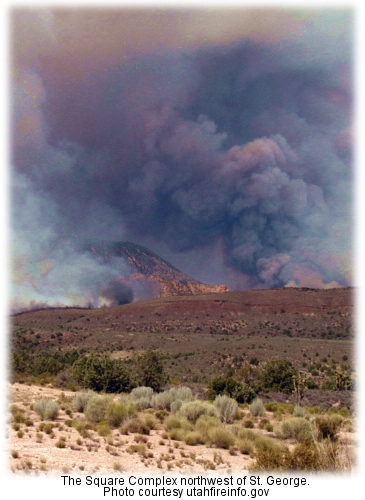 The complex consists of two fires that started Saturday morning and burned together around Square Mountain in rugged terrain of mountain brush, piñon-juniper, and sagebrush. The complex consists of two fires that started Saturday morning and burned together around Square Mountain in rugged terrain of mountain brush, piñon-juniper, and sagebrush.
Incident Commander Larry LeForte, with the Division of Forestry, Fire and State Lands, told the Salt Lake Tribune that firefighting efforts will escalate today, with a national management team taking over and additional crews coming in from around the country.
LeForte said that three SEATs and four helicopters were busy on the fire and that a ranch in the area was evacuated yesterday as a precaution. Crews were pulled off the fireline for two hours yesterday afternoon for safety reasons after thunderstorms moved over the fire and downward winds threatened to spread it rapidly.
Turbulent air conditions forced the grounding of the airtankers late in the afternoon.
"The fire did some pretty good runs today," said LeForte. "We're not being helped by Mother Nature, that's for sure."
The fire is one of about 20 ignited by lightning in southern Utah since Friday. Smokejumpers were fighting the 7-acre Hollow Fire in a remote area north of St. George on the Dixie National Forest.

HIGH WINDS FLARE ANOTHER UTAH FIREJUNE 27 -- ST. GEORGE, UTAH: A wind-pushed wildfire ignited by lightning on Friday burned 6,000 acres today, according to KSL-TV out of Salt Lake City, pushing the fire to about 12,000 acres. High winds kicked up the fire, burning near St. George. The fire yesterday burned to within a mile of a major utility area, but crews managed to clear enough of the fuels to keep the fire from shutting the area down.
"This particular one just really heated up and took off," said David Boyd, a BLM fire information officer. "It's been smoldering all morning, but it's really making a run now." He said all but a few hundred acres of the 12,000-acre fire had burned since yesterday afternoon.
More than 200 firefighters, five helicopters, and an airtanker were on the fire today. KSL-TV has video clips online.

FIRE ON THE TONTO DOUBLES IN SIZE, SOUTHWEST BUSYJUNE 27 -- TUCSON, AZ: Dry vegetation and high winds combined today to fuel the growth of a wildfire on the Tonto National Forest to more than 10,000 acres. The Willow Fire in the Mazatzal Wilderness Area doubled in size today. Though the fire is still miles away from private property, crews have been backfiring to protect ranches. The AP reported that forest roads near the ranches have been closed.
The fire's rapid growth over rugged terrain prompted the order for another incident management team; the fire's less than 10 percent contained, with four helicopters, three other aircraft, and about 200 personnel assigned.
Farther north in Arizona, crews were mopping up a 25-acre fire this morning on the Fort Apache Reservation about six miles northeast of Cedar Creek. The Walnut Springs Fire was first spotted around 6:30 p.m last night. Because of extremely dry fuel conditions, fire suppression activities were immediate, involving airtanker drops, dozers, engines, and crews. Approximately 155 people were still on the fire this morning.
BLM-Yuma personnel were this afternoon working the Jerry Can Fire, at 80 acres, just west of San Luis, Arizona, and crews were busy on the Welch Fire, under BIA jurisdiction, estimated at 250 acres about 11 miles north of Ehrenberg, Arizona. Another fire this afternoon was burning about 10 miles southeast of Cordes Junction, estimated at 200 acres including burnout, and Oltrogge's Type 1 team was ordered this morning for the Nuttall Fire on the Coronado. No word yet on whether R3 will follow suit and refuse assignments for IMTs that include non-federal command and general staff, as R5 has ordained.

NEW FIRE MARSHAL AND DIRECTOR
NAMED FOR CALIFORNIAJUNE 27 -- SACRAMENTO, CA: Gov. Arnold Schwarzenegger named two municipal fire chiefs as state fire marshal and director of CDF on Friday, highlighting the importance of firefighting following southern California's firestorm last fall. He chose Dale Geldert to head CDF, bringing the 61-year-old out of retirement. The AP reported that Geldert most recently was fire chief and deputy city manager for the city of Oceanside from 1992 to 2002.
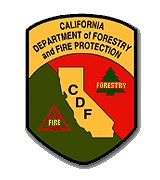 Palo Alto Fire Chief Ruben Grijalva, 49, was named state fire marshal. Grijalva has been chief there since 1994, and before that was the department's assistant fire chief. Palo Alto Fire Chief Ruben Grijalva, 49, was named state fire marshal. Grijalva has been chief there since 1994, and before that was the department's assistant fire chief.
Geldert was a CDF forest ranger from 1988 to 1991, on the fire side of the department's dual mission. Republican former Gov. Pete Wilson appointed Geldert to the Board of Forestry and Fire Protection in November 1996, where he served until January 1999 as chairman of the California Fire Protection Committee and the Firescope Northern Operations Committee.
California Forestry Association President Dave Bischel said Geldert "clearly has the kind of experience and understanding to deal with the most significant issue that our forests face today, which is catastrophic wildfire and developing a strategy to deal with that issue."
CDF fights an average 6,300 wildland fires a year on 31 million acres of nonfederal land. The Office of the State Fire Marshal is a part of CDF, focusing on structure fires.

SIERRA WILDFIRE THREATENS USMC BASEJUNE 27 -- COLEVILLE, CA: High winds yesterday pushed a fire to 700 acres, threatening a Marine Corps housing facility along the eastern Sierra Nevada. Firefighters said they had no containment lines around the fire as of late yesterday afternoon, and were concerned that winds could push the fire toward the housing unit north of Coleville, 80 miles south of Reno, Nevada.
The facility houses personnel at the U.S. Marine Corps Mountain Warfare Training Center in Pickel Meadows near Sonora Pass.
Fire information officer Franklin Pemberton said homes and other structures in the Holbrook Junction and Topaz Lake areas of Nevada also were also threatened, and the AP reported down-canyon gusts of up to 40 mph.
According to staff at the Sierra Front Interagency Dispatch Center in Minden, the fire shut down U.S. 395 from the Nevada line to Bridgeport last night, but the highway was reopened this morning. About 250 firefighters were assigned, along with several helicopters and an airtanker.
Meteorologists are expecting another day of dry isolated thunderstorms across northern Nevada today.

CHICKEN EVACUATEDJUNE 26 -- ANCHORAGE, ALASKA: A 90-mile stretch of highway in Alaska is closed because of wildfires, and officials are trying to get more stranded people out of the tiny town of Chicken. About 100 people are still in the mining community near the Canadian border, according to a report by WRAL-TV, and the 33,000-acre fire is about a mile south of Chicken. About 100 people were ferried out of Chicken in a caravan of RVs and other vehicles yesterday. Another convoy carried supplies into town with fires burning on both sides of the highway. Information on the status of Chicken has been sketchy because there are no land phone lines in the area.
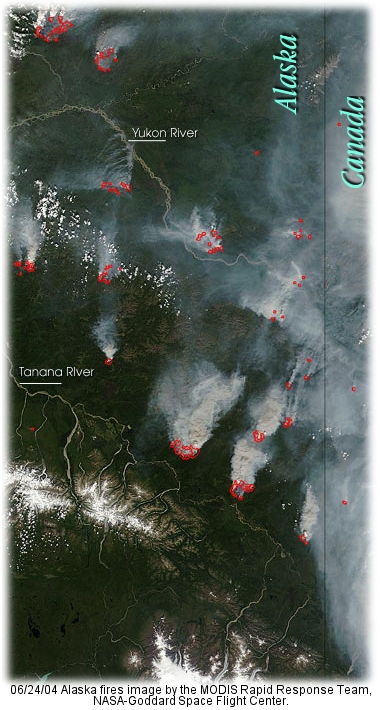 Craig McCaa, a fire information officer in Tok, said that three fires fueled by light winds and hot, dry air prompted the closure of the Taylor Highway on Thursday on both sides of Chicken. According to an AP report, Chicken has a population of 21. Seasonal miners and travelers were also stranded there. Craig McCaa, a fire information officer in Tok, said that three fires fueled by light winds and hot, dry air prompted the closure of the Taylor Highway on Thursday on both sides of Chicken. According to an AP report, Chicken has a population of 21. Seasonal miners and travelers were also stranded there.
Huge, smoky fires are burning throughout east-central Alaska; most of the fires were triggered by lightning around June 14 and 15, when a record-breaking 8,500 strikes hit the state in just 24 hours. The image at right is from the Moderate Resolution Imaging Spectroradiometer (MODIS) on the Terra satellite; it shows the region lit up with fires billowing large amounts of smoke, which hangs over the Yukon Territory, Canada. Areas where MODIS detected active fires are outlined in red.
At the top of the image are the Pingo (top) and Winter Trail (to the southeast) Fires, each of which was more than 50,000 acres as of June 24 when the image was captured. Along the Tanana River in the lower part of the image, the Billy Creek Fire has been putting up a massive smoke plume. To the southeast of the Billy Creek Fire, the Porcupine Fire is putting up a smaller, but nonetheless impressive column of smoke.
Image courtesy the MODIS Rapid Response Team, NASA-Goddard Space Flight Center.
Andy Alexandrou, a fire information officer at the Alaska Interagency Coordination Center at Fort Wainwright, said the eastern half of the state from Fort Yukon to Eagle to Northway and east to the Yukon Territory is experiencing extreme fire behavior. Fairbanks, Delta Junction, and Tok, according to the Fairbanks Daily News-Miner, are considered in the high to extreme fire danger rating. Of the 53 active fires in the state, 11 are being staffed, Alexandrou said, and those 11 fires are in the Interior.
The National Weather Service is predicting even hotter temperatures through the weekend, making an already busy fire season more volatile.
"It's going to get busier," said Alexandrou, a retired fire management officer out of McGrath. "Basing it on my previous background, I do think we're in for more activity."
A total of 350,650 acres have burned in 298 fires statewide so far this year, coming close to catching the 352,061 acres that have burned thus far in the Lower 48. The 1,000-acre Wall Street Fire was threatening to burn a campground, the Chicken No. 1 fire was at 33,000 acres, and the Porcupine Fire crossed the Taylor Highway at 16.5 Mile and has burned more than 13,000 acres. The 10,000-acre American Summit Fire outside Eagle is being staffed by the Alaska Fire Service. Crews have made significant progress on the Solstice Complex north of Fort Yukon and 10 of the 16 fires have been contained. Two are being monitored and four others are staffed.
Because of active fires and smoky conditions, the Taylor Highway was closed from the Alaska Highway to just past the Jack Wade Junction, the point where the Top of the World Highway begins and the Taylor Highway continues on to Eagle. The Steese Highway also has been closed intermittently. When it's open, a pilot car leads traffic starting at 45.5 Mile to Sourdough Creek at 65.5 Mile.

DALTON HOTSHOTS HIT BY LIGHTNINGJUNE 25 -- TUCSON, AZ: Crewmembers on the Dalton Hotshots were injured by lightning yesterday afternoon while working on the Noon Fire on Mt. Graham. Scott Gorman and Jeff Every were evacuated by helicopter and flown to the helibase at the base of the mountain; they were then transported to a hospital in Safford. Both were admitted for treatment and 48-hour observation.
The hotshots reportedly suffered first-degree burns, and one reported numbness in the lower limbs. Some disorientation was reported last night, but has since been reduced, and both are reportedly alert and stable. Two other crewmembers, Travis Anway and Brandon Burrill, walked off the fire and were later taken to the hospital and are also being kept there for observation.
A Critical Stress Debriefing Team was ordered to meet with the remainder of the crew, and personnel from the Angeles are conducting an After-Action Review today.
The Noon Complex where the crew was working consisted of three fires. Two additional fires were ignited in the Mt. Graham area by the same storm that injured the hotshots.
The lightning-caused Noon Fire started on the evening June 22 in rugged terrain in the Pinaleno Mountains about 12 air miles southwest of Safford. According to personnel on the Coronado National Forest, five crews of hotshots were working on the fireline at about 7000 feet when the fast-moving thunderstorm approached. The lightning strike thought to have been responsible for the firefighters' injuries was probably the first -- or one of the first -- strikes. The injured firefighters were on a rocky slope, and were probably injured by electrical current traveling underground rather than a direct hit.
Two hotshot crews are working on the Noon Fire today, patrolling the fireline and mopping up.
The Dalton Interagency Hotshot Crew is based on the Angeles National Forest in Glendora, California; the crew was on assignment to the Coronado National Forest at the time of the incident. The hotshots were evacuated by the 305th Rescue Squadron, an Air Force Reserve Unit stationed at Davis Monthan Air Force Base.
Fire managers have cautioned that afternoon cloud buildups of late have been accompanied by lightning, and all fire personnel should use extreme caution. Lightning can pose a danger even from miles away. If you see lightning in the area where you are working, take cover in your vehicle or move off ridgetops and away from tall trees or other objects.

NEW 125-ACRE FIRE ON THE TONTOJUNE 25 -- TUCSON, AZ: The Willow Fire, ignited by lightning yesterday on the Tonto National Forest, was at 125 acres this morning, burning near Horseshoe Lake. Three helicopters and two hotshot crews are working the fire, and the Forest Service says two C-130 MAFFS units are available if needed. KVOA-TV reported that three other small lightning-caused fires on the Tonto are being monitored.
The Payson Roundup reported that all of the Tonto is now under fire restrictions. Restrictions on campfires, smoking and other activities were extended Wednesday to include all of the Tonto, Apache-Sitgreaves, Coconino, and Prescott national forests.
The Jacket Fire on the Coconino National Forest, which started on Tuesday, is at 600 acres with zero containment. It's southeast of Winona, Arizona, burning in grass and piñon-juniper, and has threatened three outbuildings. An abandoned homestead on private land was wrapped with fire-resistant material for protection. The fire yesterday was very active in dead piñon, with torching and profuse spotting. The fire's being monitored.

PILOT SAYS AIRTANKERS ARE SAFEJUNE 24 -- SILVER CITY, NM: The 33 heavy tankers grounded by federal fire officials in May, allegedly because of safety issues, are "absolutely safe," according to a Silver City pilot.
Bill Waldman, a pilot with Aero Union, he has been flying airtankers for 36 years, and he told the Silver City Daily Press that with 162 years of service time, the airtankers have experienced just five accidents while engaged in firefighting activity. Waldman pointed out that no one on the ground was ever killed or injured in any of the accidents, despite recent comments about such possibilities from the Forest Service and USDA officials.
"None of the types of airtankers currently in the fleet have had any structural failures," said Dean Talley with the Associated Airtanker Pilots. "No one on the ground has ever been killed or injured in an airtanker accident. Allusions to these sorts of disasters are theatrical," said Talley in a recent guest editorial in the Chico News and Review.
In years past, one of the heavy airtankers has usually been based at the Grant County Airport during southwest New Mexico's spring and summer fire season. This year, the Forest Service is using SEATs and helicopters instead.
Waldman says the Forest Service's citing of safety concerns in canceling the airtanker contracts is nothing but a "red herring." The real reason for the decision, he said, was that the agency was concerned about its liability after the NTSB determined the Forest Service is responsible for ensuring the airtankers' airworthiness.
But, he said, the agency does not have the expertise to do so. "So, because of the liability, they canceled the contract," said Waldman.
"The Forest Service is putting out the spin they have all these substitute resources," he said. "What they don't tell you is that the single-engine airtankers have a limited capacity." He explained that the use of SEATs on fires in light fuels is one thing, but that they're of limited use on a forest fire. Waldman provided a Forest Service fact sheet about the single-engine aircraft, which states: "SEATs are very effective in light and moderate fuels such as grass and brush. They can operate on timber fires, but don't carry a sufficient volume of liquid to penetrate most timber canopies."
The SEATs, he said, are designed to fight grass fires and light-fuel fires. But the Forest Service fact sheet claims that SEATs, "due to their smaller size and flight characteristics, have an advantage over larger, fixed-wing aircraft in their ability to maneuver over fires and deliver liquid more accurately and effectively." But Waldman said SEATs are not more maneuverable than the big airtankers when at high altitude, in mountain terrain, with heavy loads.
Most of the pilots in fire -- and increasingly more fire managers on the ground -- have criticized the federal agencies' decision to cancel airtanker contracts. They say that a very important tool in the box has been removed from the firefighters' ability to fight the wildfire battle. "The people who fight fire do so with the same intensity others reserve for war," says Talley. "In the past, losses were accepted as a fact of life, and there were too many. This is not something that cropped up in the last 10 years, as suggested by Forest Service leadership. Working in one of the harshest flight environments imaginable, the industry has had a safety record that has continued to improve over time, in spite of chronic under-funding and a lack of leadership to resolve the structural problems within the Forest Service and BLM."
"The facts are available, but they are not in sound bites and public-relations dispatches," adds Talley. "The agencies are more afraid of the past than the problems they are creating for the future."

CAMERAMAN ACCUSED OF SETTING WILDFIRE
WILL BE RETRIEDJUNE 24 -- LOS ANGELES, CA: A Superior Court judge has set a retrial for July 23 in the case of a cameraman accused of setting a wildfire in Leona Valley two years ago. A jury in March acquitted 23-year-old Joshua Harville of Palmdale on five counts of arson; the jury split on two counts of aggravated arson.
NBC4-TV reported that Los Angeles County prosecutors said they will retry Harville on the two aggravated arson charges. Harville allegedly set the fire so he could get exclusive TV footage of the fire.
The 5,100-acre fire in September 2002 destroyed five homes and evacuated about 200 residents.

HAND CREWS NOT LIKELY IN MAGALIAJUNE 24 -- CHICO, CA: The fire center in Magalia is empty, and state budget negotiations are still ongoing in the state's capital; by now the fire center should be busy with two fire crews in training. Funding for the usually busy fire crews hasn't been committed yet by the state Department of Finance, and local fire managers aren't certain that it will be.
And, as the Chico Enterprise-Record reported, many of the candidates for firefighter positions on the crews have now hired on with private firefighting contractors or found other summer jobs.
"Everybody who is qualified is already committed elsewhere," said Don Steele, a director with the Butte County Fire Safe Council.
The Magalia Fire Center for years has housed as many as 60 members of the California Conservation Corps. New barracks were built about four years ago, housing crews that were trained to work on wildfires. Other public service work such as trail clearing and construction of fuel breaks was also done by the crews. But budget cuts forced the state to disband the CCC crews before the start of last year's fire season.
About 30 seasonal and entry-level CDF personnel were stationed in Magalia last summer. But there's no money for that this year, according to CDF Battalion Chief Mark Nelson.
"This could leave us short one of our biggest tools," he said.
With the CCC gone and CDF's lease expired on a building in Durham, the agency has mostly used the Magalia facility as a regional fire training center. Steele said that inmate crews will be available, but they might be dispatched to almost anywhere in California during fire season.
Even if funding becomes available, Nelson says it takes several weeks to screen, hire, and train new applicants -- it could be mid-August or later before Magalia's got fire crews again. "Given the weather pattern that's been forecast," said Steele, "I think we'd better start bugging Sacramento."

AGENCY OFFICIALS DIFFER ON AIRTANKER ISSUEJUNE 23 -- MESA, AZ: A beefed-up fleet of helicopters and SEATs, along with MAFFS support, is just as good at fighting Arizona fires as the large airtankers canceled earlier this year by federal officials -- or that's what the feds say.
But other fire managers disagree.
"One of the tools isn’t in the toolbox anymore," Deputy State Forester Kirk Rowdabaugh told the East Valley Tribune. "The resources have been compromised."
Such differing opinions reflect just part of the debate about the cancellation of the heavy airtankers. The "reconfiguration" of the country’s air resources -- though expensive -- will cover the loss of the grounded planes, said officials with the Bush administration who visited Arizona on Monday. During a news conference at Williams Gateway Airport in Mesa, Interior Secretary Gail Norton said the country is entering a new phase of wildfire management.
"We can double the amount of firefighting capability as in the past, and at the same time we increase the safety," she said.
Undersecretary of Agriculture Mark Rey, also in Mesa, said 139 extra helicopters and airplanes have been put on to make up for the loss of the large airtankers -- at a cost of $66 million. He said that includes 23 helicopters and 19 SEATs in Arizona, along with two military C-130 MAFFS aircraft based at Williams Gateway.
"It’s what we think is adequate to deal with that level of risk," said Rey. He said so far this year, 98.5 percent of 805 fires in Arizona were contained in the initial attack phase, but only 93.5 percent of 332 fires were caught in initial attack by this time last year.
But Rowdabaugh said those figures are misleading. The number of fires started by people this year -- typically the worst fires -- is down by 30 percent. The 10-year average for human-caused fires by Monday’s date is 441, but so far humans have only started 319 fires, he said.
Rowdabaugh said large airtankers are the most efficient, effective firefighting tool available. "These other aircraft, they are not exact replacements," he said.

DELAYS IN GETTING AIRCRAFT DEPLOYED
REPORTED IN ALBUQUERQUEJUNE 23 -- ALBUQUERQUE, NM: Either erroneous information or jurisdictional problems -- or both -- delayed the air attack on the most recent Bosque fire near Belen, New Mexico, according to a report by KRQE-TV out of Albuquerque. Airtankers based there were delayed by an hour on June 18 while winds pushed the wildfire towards homes, and federal fire managers are changing the jurisdiction rules to get firefighting aircraft dispatched more quickly.
When the Bernardo Fire started, it was quickly spotted by a local fire patrol aircraft. But when the crew reported the fire, they were told it was a prescribed burn and was being monitored by a different fire management jurisdiction.
Aircraft were sitting on the ground just minutes away in Albuquerque, but weren't launched till the State Forestry Division arrived on the fire and requested their help.
An hour after the fire was spotted, a SEAT from Albuquerque arrived. Two hours later, a firefighting helicopter arrived.
Because the fire was burning just south of the Albuquerque fire management zone, the Gila Zone headquarters more than 150 miles away in Silver City was in charge. Since then, changes have been made. Effective immediately, the Albuquerque zone is being expanded to encompass all of the Bosque, from Albuquerque to Elephant Butte. Also, when a Bosque fire is reported, aircraft will be immediately dispatched, instead of sending just a recon plane.

NTSB INVESTIGATION UPDATED ON SEAT CRASH IN UTAHJUNE 23 -- ST. GEORGE, UTAH: The National Transportation Safety Board has updated its information on the investigation into the June 17 crash of an M-18 Dromader airtanker on the Dammeron Complex in southern Utah. Wayne Turner, 58, of Big Sandy, Montana, was killed during firefighting operations on the complex.
The SEAT was under the operational control of the BLM and the NTSB said that aircraft visual meteorological conditions prevailed at the time of the crash. Both ground and airborne eyewitnesses reported that the aircraft had just completed a retardant drop while flying less than 100 feet above downsloping terrain. Immediately after the drop, the aircraft pitched down and descended steeply into wooded terrain. The pilot did not report any problems prior to the accident.
According to BLM representatives, Turner had about 21,000 hours of experience, mostly in crop dusting. He had about 35 hours in the Dromader M-18, of which about 25 hours were flown during simulated and operational firefighting operations during last year's fire season. The pilot also recently had three hours of additional training by the BLM in Safford, Arizona.
The accident flight was the pilot's third or fourth retardant drop of the day; he had completed two drops on the day before the accident. Turner was a relief pilot; the primary pilot, who had flown the plane for three years, did not report any problems with the plane prior to the accident.
According to witnesses, Turner made two dry runs over the intended drop area before releasing the retardant on the third pass. During the drop run, he was off course and released the retardant earlier than desired.
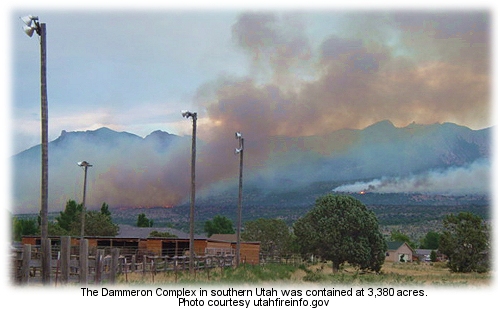
NTSB interviews with Dromader pilots in airtanker operations indicated that some of the pilots were flying the drop run at an airspeed that was slower than the recommended airspeed for a retardant drop. Because of this, the National Program Manager for the SEAT fleet on Saturday halted operation of the 26 contracted Dromaders for two days so that pilots could review operational specifications of the aircraft. The "safety stand down" was lifted on Monday morning, and the Dromader pilots are now continuing firefighting operations.
Eight of the 26 Dromaders are turbine-powered, and the rest are powered by radial engines -- as was Turner's aircraft on the Utah fire. The Dromaders make up about one-third of the federal fleet of 79 SEATs.
A team of NTSB, FAA, DOI, and BLM investigators examined the accident site and wreckage one day after the crash. Evidence indicated that the aircraft impacted the ground in a near vertical, nose-down attitude. No evidence of structural failure, flight control discrepancy, or obvious catastrophic engine failure was noted at the site. The wreckage has been recovered and will be examined in detail in Phoenix, Arizona, by a team of NTSB investigators later this week.
The aircraft maintenance records were on board at the time of the accident and were destroyed in the post-crash fire.
This was the third fatal accident involving a Dromader M-18 airtanker in the past three months. All three planes were owned by Montana-based New Frontier Aviation. The first accident occurred on March 16 near Safford, Arizona, on a practice retardant drop during training exercises. The aircraft was destroyed and the pilot was killed. The plane was loaded with 400 gallons of water, and while turning left to the base leg, the plane's engine surged two or three times. Witnesses said it assumed an "unusual attitude" with the right wing up and the nose down until they lost sight of it behind a small ridgeline.
The second accident occurred on May 22 when another SEAT collided with mountainous terrain, killing the pilot, near Borah Peak, Idaho, in adverse weather conditions. The plane was on a visual flight rules (VFR) cross-country flight from Dillon, Montana, to Boise, Idaho, where it was to begin service for the BLM.
The Color Country Fire Management Area has established a memorial fund for the family of Wayne Turner, the SEAT pilot who was killed on the Dammeron Fire. To donate to this fund, send a check to Dixie Employee Association, Attn: Julianne Green, 1789 N. Wedgewood Lane, Cedar City, Utah, 84720. For more information, call (435)865-3700.

PLEASE DON'T SUE YOUR VFDJUNE 22 -- EUGENE, OR: Three years ago, a 15-year-old boy slipped and fell while climbing a cliff on the rim of the 300-foot-deep Crooked River Canyon in central Oregon. He fell 25 feet and landed on a narrow ledge. Though badly hurt, he was conscious when volunteers from the Crooked River Ranch Rural Fire Protection District arrived. Rescuers rappelled down the cliff face, using chainsaws to clear their way through thick sagebrush.
Twenty minutes after reaching the injured boy, paramedics had him loaded into a rescue basket and hoisted him out of the canyon. He was helicoptered to a hospital, where he later died.
And his parents are suing the volunteers -- for $9.5 million.
An editorial in today's Register-Guard asserts that rural communities depend on the thousands of men and women serving without pay as firefighters, EMTs, and search and rescue volunteers. The editorial points out that unacceptable and unavoidable results are likely from such lawsuits. "First, there will be an unavoidable tendency to delay, review, second guess or overanalyze situations which by their nature are fluid, unpredictable and require snap decision making."
"Their willingness to face danger for so little is priceless," says the editorial. "We must do everything we can to protect our protectors, or face the possibility of having fewer people on hand to answer our 911 calls."

B.C. WILDFIRE INCREASES FIVE-FOLDJUNE 21 -- LILLOOET, BRITISH COLUMBIA, CANADA: A British Columbia wildfire grew today to five times its size in about 24 hours; some 200 firefighters are on the fire north of Lillooet, where 3,000 people are on evacuation alert.
The Dickie Creek Fire grew to 1,500 hectares (3,700 acres) today from 300 hectares (740 acres) yesterday, and the fire's expected to continue spreading because of extreme heat, dropping humidity levels, and dry weather conditions, according to the Globe and Mail. Local officials have advised that the fire's affected the town's water supply and residents are advised to boil water before using it.
Last year 30,000 residents were forced to leave their homes during one of the most disastrous fire seasons in British Columbia.

NEVADA FIRE DOUBLES IN SIZEJUNE 21 -- MESQUITE, NV: The Nickel Fire near Mesquite, northeast of Las Vegas, is burning in piñon, brush, and grass, and made serious runs to the north and east yesterday, where it burned into heavier fuels and more than doubled in size.
An AP report this afternoon said that five helicopters and 375 firefighters from federal, state, and county agencies were working the fire, and that the ICP was established today in Bunkerville.
Whalen's Type 2 team is on the fire, and reported yesterday that rough terrain and a lack of water for helicopter support were major concerns. Fire behavior was active through the night, but did quiet down some this morning. The fire burned across the state line into Arizona; it's 20 percent contained at about 8,300 acres.
A large wilderness area bounded by the community of Mesquite and Interstate 15, the Virgin River, Lake Mead, and the Arizona border was closed to off-road and recreational uses because of firefighting operations. The area includes the Virgin Mountain Natural Area and Virgin River Recreation Lands northeast of Las Vegas.

DROMADER SEATS GROUNDEDJUNE 21 -- BOISE, IDAHO: The National Interagency Fire Center in Boise on Saturday temporarily grounded all PZL M18 Dromader SEATs, forbidding them from flying on federal fires for the rest of the weekend.
The Stand Down Alert said the possibility exists that drop speed minimums have been misinterpreted.
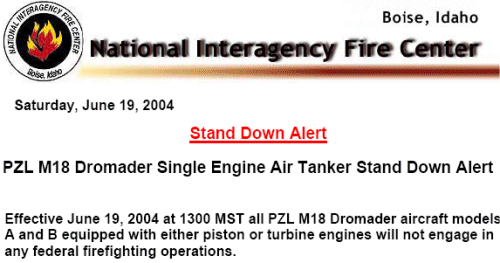
Pilots were asked to review published charts and flight manuals and information on drop speeds at the weights common to fire suppression operations.
The notice said that all affected aircraft will return to service June 21 unless otherwise notified by the National Aviation Office.

ARIZONA FIRE DIES DOWN AFTER
EVACUATING 1,000 RESIDENTSJUNE 21 -- WHITE RIVER, AZ: A wind-driven fire chased about 1,000 people from their homes in eastern Arizona before improved weather conditions allowed fire crews to get the fire near containment. The China Fire near White River threatened 200 to 300 homes yesterday, and at one point burned to within 100 yards of some houses, according to an AP report. Chadeen Palmer with the White River Apache Tribe said that residents were told to leave during the afternoon, but were allowed to return by 9 p.m. after crews put in a fire break. The fire was 95 percent contained at 110 acres.
Wind kicked up the fire quickly but then eased. "It just did its thing, curled up and died," Palmer said.
Two airtankers and a helicopter dropped water on the fire.
Reduced winds in west-central New Mexico also helped with an 8,595-acre fire in the Zuni Mountains near Grants; the Sedgwick Fire on the Cibola National Forest started June 12 and was contained yesterday at 8,595 acres.
The Bernardo Fire in New Mexico is 50 percent contained at 354 acres, and the Three Forks Fire on the Apache-Sitgreaves National Forest west of Alpine, Arizona, is 95 percent contained at 7,905 acres. The Peppin Fire on the Lincoln northeast of Capitan, New Mexico, is at 64,488 acres with 96 percent containment.

DOWNED PILOT A REAL PROJUNE 20 -- ST. GEORGE, UTAH: Wayne Turner of Big Sandy, Montana, was killed Thursday when the SEAT he was flying crashed while working the Dammeron Complex in southern Utah.
Turner, 58, a contract pilot with more than 21,000 hours of flying experience, flew for New Frontier Aviation out of Fort Benton, Montana.
Dean Bomgardner at Taylor's Aviation in Fort Benton told the Great Falls Tribune that he's known Turner for 20 years. He said Turner was an instructor and an extremely skilled pilot.
"He did everything by the book," Bomgardner said. "We're going to miss him."
New Frontier Aviation is owned by Andy Taylor of Taylor's Aviation.
Turner taught dozens of Montana pilots to fly during his long and varied career, according to his peers in Montana. He was among the state's few Federal Aviation Administration examiners.
"He was one of the most knowledgeable, dedicated, experienced pilots around," said Chouteau County Commissioner Jim O'Hara, a flight instructor to whom Turner often referred students. "He was very professional, very aviation-oriented, just the kind of guy that wasn't prone to make mistakes."
"It's just shocking," added O'Hara, "I just can't figure it out."
O'Hara said that when Turner wasn't flying a plane, he was in the hangar working on one. He lived across the street from the Big Sandy airport, and had worked as a crop-duster in the Chouteau County area for more than 20 years.
"He was very conscientious about what he did as an ag pilot," said Montana state Senator Jon Tester. "Wayne would always call you up if there was any question about wind directions or things like that."
The southern portion of the Dammeron Complex, at 3,600 acres, hasn't spread much since Thursday morning. Interior islands of fuel continued to burn yesterday, with isolated pockets of torching, but the main portion of the complex has been contained.

CHIEF BELIEVES THERE'S HOPE FOR AIRTANKERSJUNE 20 -- MISSOULA, MT: Forest Service Chief Dale Bosworth said yesterday he thinks some of the heavy airtankers will return to service following a review of their safety records. In Missoula for the 50th anniversary rededication of the Forest Service's Aerial Fire Depot, Bosworth said the agency is not trying to end the airtanker program.
"I hope and believe there is a future for airtankers," he said.
Since the May cancellation of federal contracts for heavy airtankers, the Forest Service and BLM have contracted with hundreds of additional helicopters and SEATs to cover the loss, and according to the Missoulian that's cost the feds more than $60 million. But Bosworth said he'd rather have heavy airtankers as part of the mix. He said contractors have been given an opportunity to prove the tankers' airworthiness by providing detailed maintenance and flight records for each aircraft. The Forest Service has contracted with DynCorp Technical Services -- which manages the fleet of S-2s in California -- to evaluate the airtankers and judge their airworthiness.
"Our hope is, we'd like a determination made fairly quickly, yes or no, on these aircraft," Bosworth said. "And if there are airtankers that pass the test, we'd like to get them back in the air this year."

CREWS BATTLING B.C. WILDFIRESJUNE 20 -- LILLOOET, BRITISH COLUMBIA, CANADA: Fire officials are setting up an operations base today at the Lillooet airport to coordinate suppression efforts on an aggressive wildfire that's got residents of at least five homes on evacuation alert. The Dickie Creek Fire near Lillooet is less than 200 metres (220 yards) from the nearest home, according to canada.com, but officials say it's burning slowly so there is no immediate threat.
The fire is about 1.5 square kilometres (370 acres) in size, burning near the town of Lillooet north of Vancouver. The Calgary Sun reported that heavy smoke was making it difficult to get an exact measure of the fire's size, and steep terrain has made some parts of the fire inaccessible to fire crews.
The Dickie Creek Fire is the largest of 11 fires ignited by lightning storms that rolled through the area Friday night; 44 new fires have been reported in the province since Friday, and eight of the 11 large fires have been contained.
Ground crews were assisted by five airtankers, with two helicopters providing additional support.
Crews are also fighting a large fire in northwestern B.C. near Fort Nelson. That fire's in a remote area but is threatening powerlines. The fires may be an indicator of a severe fire season ahead; British Columbia residents still have fresh memories of the huge fires that burned in the southern interior last year.

THE HOMERS AND JETHROES ARE OUT THEREJUNE 20 -- HELENA, MT: Private firefighting contractors in Montana and across the West are trying to raise standards in their industry and weed out sloppy operators who give the professionals a bad name.
"The 'Homers and Jethroes' are out there," said Joe King, a former U.S. Forest Service fire boss who is now chief of operations and training at Montana Wildfire Inc. in Bozeman, referring to private contract firefighters who try to cash in on fire season without spending adequate money on training or equipment.
The Missoulian reported that for the last three years, a group of contract firefighters have been trying to set high standards and eliminate the sloppy operators. The Northern Rockies Wildfire Contractors Association recently met in Billings. Curt Milledge, a board member of the Central Montana Contractor's Association who leases fire equipment to the state, said other groups of contractors have formed smaller professional groups aimed at bringing order and standards to the fast-growing industry.
"We need to raise the bar," King said. "We have to instill professionalism."
State and federal fire bosses rely on private contractors like King and Milledge for wildfire suppression work. Bruce Suenram, a Montana City wildfire contractor and president of the NRWCA, said state and federal standards sometimes go out the window when wildfires blow up.
"When there's a big crisis going on, our companies who invest a lot of money in meeting the standards are getting paid the same as the companies who don't," he said. The fire-contracting industry has grown dramatically in recent years, particularly in the Pacific Northwest. That rapid growth has resulted in a wide range of quality from one contractor to the next, with many new contractors in the business with little experience.
The National Wildfire Suppression Association in Oregon is a national group of fire contractors. Organized as a non-profit, the association has chapters throughout the U.S., with about 10,000 total employees among its members. The NWSA created a national database system that tracks training records for all members and can be accessed by fire agencies to verify identity and training records. Formed in 1990, the NWSA training program meets or exceeds standards of the National Wildfire Coordinating Group.

MISSOULA JUMPERS CELEBRATE ANNIVERSARYJUNE 19 -- MISSOULA, MT: Missoula is paying tribute to its wildland firefighting past today, scrambling the Missoula smokejumpers, hosting historic aircraft, and making airtanker drops courtesy of Neptune. The 50th anniversary rededication of the U.S. Forest Service's Aerial Fire Depot runs from 1 to 5 p.m. at the Forest Service complex on U.S. Highway 12 West, and includes tours of the fire cache, Fire Sciences Lab, Northern Rockies Fire Training Center, and the Missoula Technology and Development Center.
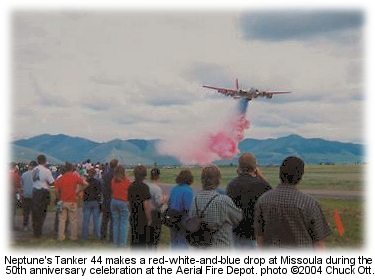 The National Weather Service Missoula office and historic aircraft on the ramp are also featured, according to the Missoulian. Four early smokejumper aircraft will be on hand, including a 1928 Travel Air that once belonged to Johnson Flying Service, a Twin Beech, a Ford Tri-Motor, and the DC-3 used to carry jumpers to the tragic Mann Gulch Fire in August 1949. The National Weather Service Missoula office and historic aircraft on the ramp are also featured, according to the Missoulian. Four early smokejumper aircraft will be on hand, including a 1928 Travel Air that once belonged to Johnson Flying Service, a Twin Beech, a Ford Tri-Motor, and the DC-3 used to carry jumpers to the tragic Mann Gulch Fire in August 1949.
Forest Service Chief Dale Bosworth, BLM director Kathleen Clark, and Bob Sallee, the last remaining survivor of the Mann Gulch blowup, will all be on hand. Neptune Aviation will make airtanker drops, with water colored red, white and blue for the occasion. Neptune is also hosting an open house from 3 to 6 p.m.
A free shuttle bus will run from the University of Montana's Adams Center parking lot beginning at noon and running every 15 minutes until 5 p.m. The shuttle and parking are courtesy of the National Smokejumpers' Association, which is holding a reunion in Missoula this weekend.
| 











 There are no "home bases" for the current reincarnation of airtanker contracts; the home base for Aero Union's P-3s will be Chico, California. A letter of inspection from DynCorp to the Forest Service was delayed by holiday mail slow-downs, which has temporarily stalled the return to service of two more P-3's owned by Aero Union.
There are no "home bases" for the current reincarnation of airtanker contracts; the home base for Aero Union's P-3s will be Chico, California. A letter of inspection from DynCorp to the Forest Service was delayed by holiday mail slow-downs, which has temporarily stalled the return to service of two more P-3's owned by Aero Union.


 Bitterroot Hotshot Nicole Lustig is in critical condition with head injuries, and Jared Bohrman is still in guarded condition with chest injuries. Both were airlifted to the UNM hospital and seven others were transported to the Socorro hospital. All but one of the seven have been released; firefighter Mike King remains in the hospital for observation. He was in good condition this morning.
Bitterroot Hotshot Nicole Lustig is in critical condition with head injuries, and Jared Bohrman is still in guarded condition with chest injuries. Both were airlifted to the UNM hospital and seven others were transported to the Socorro hospital. All but one of the seven have been released; firefighter Mike King remains in the hospital for observation. He was in good condition this morning.
 The complex consists of two fires that started Saturday morning and burned together around Square Mountain in rugged terrain of mountain brush, piñon-juniper, and sagebrush.
The complex consists of two fires that started Saturday morning and burned together around Square Mountain in rugged terrain of mountain brush, piñon-juniper, and sagebrush.
 Palo Alto Fire Chief Ruben Grijalva, 49, was named state fire marshal. Grijalva has been chief there since 1994, and before that was the department's assistant fire chief.
Palo Alto Fire Chief Ruben Grijalva, 49, was named state fire marshal. Grijalva has been chief there since 1994, and before that was the department's assistant fire chief.
 Craig McCaa, a fire information officer in Tok, said that three fires fueled by light winds and hot, dry air prompted the closure of the Taylor Highway on Thursday on both sides of Chicken. According to an
Craig McCaa, a fire information officer in Tok, said that three fires fueled by light winds and hot, dry air prompted the closure of the Taylor Highway on Thursday on both sides of Chicken. According to an 

 The National Weather Service Missoula office and historic aircraft on the ramp are also featured, according to the
The National Weather Service Missoula office and historic aircraft on the ramp are also featured, according to the